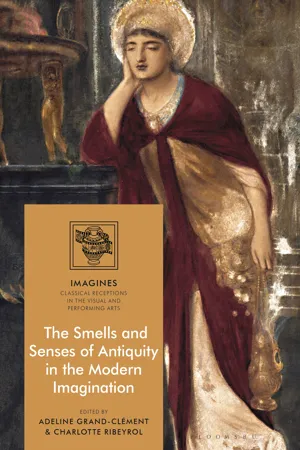
The Smells and Senses of Antiquity in the Modern Imagination
- 288 pages
- English
- ePUB (mobile friendly)
- Available on iOS & Android
The Smells and Senses of Antiquity in the Modern Imagination
About This Book
This volume tackles the role of smell, under-explored in relation to the other senses, in the modern rejection, reappraisal and idealisation of antiquity. Among the senses olfaction in particular has often been overlooked in classical reception studies due to its evanescent nature, which makes this sense difficult to apprehend in its past instantiations. And yet, the smells associated with a given figure or social group convey a rich imagery which in turn connotes specific values: perfumes, scents and foul odours both reflect and mould the ways in which a society thinks or acts. Smells also help to distinguish between male and female, citizens and strangers, and play an important role during rituals. The Smells and Senses of Antiquity in the Modern Imagination focuses on the representation of ancient smells - both enticing and repugnant - in the visual and performative arts from the late 18th century up to the 21st century. The individual contributions explore painting, sculpture, literature and film, but also theatrical performance, museum exhibitions, advertising, television series, historical reenactment and graphic novels, which have all played a part in reshaping modern audiences' perceptions and experiences of the antique.
Frequently asked questions
Information
PART I
WHAT SMELL IS THE SACRED? THE SENSORIALITY OF ANTIQUE RITUALS
CHAPTER 1
‘UNGUENT FROM A CARVEN JAR’: ODOUR AND PERFUME IN ARTHUR MACHEN’S THE HILL OF DREAMS (1907)
Table of contents
- Cover
- Half-title Page
- Series Page
- Title Page
- Contents
- List of Illustrations
- List of Colour Plates
- Notes on Contributors
- Acknowledgements
- Introduction: The Fragrant and the Foul: What did Antiquity Smell Like?
- Part I What Smell is the Sacred? The Sensoriality of Antique Rituals
- 1 ‘Unguent from a Carven Jar’: Odour and Perfume in Arthur Machen’s The Hill of Dreams (1907)
- 2 Incense and Perfume for Isis: The Sensory Reconstruction of the Isiac Ritual in Pompeii in Visual Art
- Part II Gendered Smells and Bodies
- 3 From Gorgons to Goop: Scent Therapy and the Smell of Transformation in Antiquity and the Holistic Health Movement
- 4 The Smell of Marble: The Warmth and Sensuality of Twenty-first-Century Classical Bodies
- Part III Sensing Otherness from Canvas to Screen
- 5 Sensing the Past: Sensory Stimuli in Nineteenth-Century Depictions of Roman Baths
- 6 Evoking Empathy: Smell in the Twenty-first-Century Reception of Antiquity
- Part IV Recreating the Fragrance(s) of the Past
- 7 Archiving the Intangible: Preserving Smells, Historic Perfumes and Other Ways of Approaching the Scented Past
- 8 The ‘Persistence’ of an Ancient Perfume: The Rose of Paestum
- 9 The Fragrance of Ancient Kyphi: An Experimental Workshop
- Part V Re-enacting the Fragrance(s) of the Past
- 10 ‘Balsama et crocum per gradus theatri fluere iussit’ (HA Hadr. 19.5): The Contemporary Reception of Smells and Senses in the Roman Theatre
- 11 Incense on the Grass: A Strongly Perfumed Libation Bearers (1999)
- 12 ‘Untarnished Experiences?’ Re-enactors and Their Appraisal of Smell as Gateway into the Ancient World
- Envoi ‘Scratch and Sniff’: Recovering and Rediscovering Roman Aromas
- Index
- Plates
- Copyright